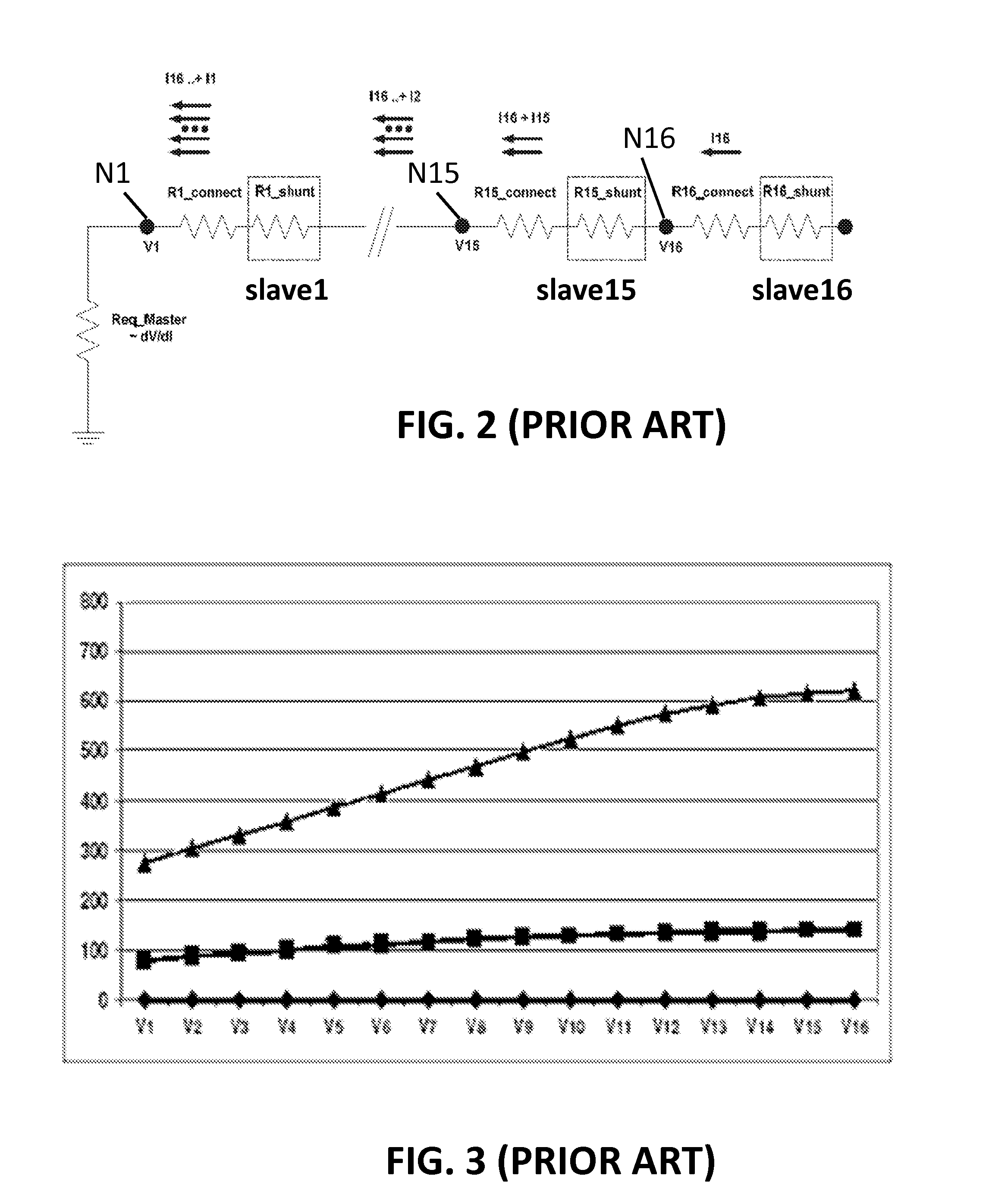Method for addressing the participants of a bus system
a bus system and participant technology, applied in the field of methods, can solve the problems of complex logistics, high cost of plugging, and complicated operation
- Summary
- Abstract
- Description
- Claims
- Application Information
AI Technical Summary
Benefits of technology
Problems solved by technology
Method used
Image
Examples
example 1
N2=1
[0099]The method will first be illustrated for N2=1, this means a process where one address is allocated to one slave in every iteration.
[0100]As shown in FIG. 7, slave16 measures the pre-selection current (I2−I1) as a nominal value of 0 mA (there are no other slaves “on its right”), but due to the measurement error of + / −0.50 mA, the value measured by slave16 lies in the range from −0.50 mA to +0.50 mA. Slave15 measures the pre-selection current (I2−I1) as a nominal value of 0.45 mA (there is one slave on “its right” providing a pre-selection current of 0.45 mA + / −10% to the bus), but due to the tolerance of + / −10% of the pre-selection current and due to the measurement error of + / −0.50 mA, the value measured by slave15 lies in the range from −0.09 mA to 0.99 mA, etc. It is noted that the uncertainty region grows for each slave, as can be seen in FIG. 7.
[0101]In order to pre-select at least one slave, the value of T1 must be chosen larger than 0.50 mA, so that at least slave16 ...
example 2
N2=2
[0107]As already indicated in example 1, it is possible to choose a value of T1 for guaranteed pre-selection of at least two slaves (that is slave16 and slave15 in FIG. 7). Indeed, if the value of T1 is chosen larger than 0.99 mA, and preferably smaller than 1.48 mA (which is the value of T1 for guaranteed pre-selection of at least three slaves), e.g. T1=1.00 mA, then it is guaranteed that two slaves (slave16 and slave15) are pre-selected, and optionally also other slaves (slave14 and slave13), the number of which is preferably as small as possible.
[0108]In the subsequent selection step, illustrated in FIG. 8, two slaves from these pre-selected two to four slaves can then be selected with certainty, moreover, they can be selected at the same time, by using a second threshold T2 and a third threshold T3.
[0109]Indeed, by choosing the second threshold T2 larger than 0.50 mA and smaller than 1.35 mA, e.g. T2=1.0 mA, slave16 can recognize itself as the “last” slave, and by choosing a...
example 4
N2=4
[0122]It is noted that the present example (with the values of CS1, CS2 and Emax mentioned above) cannot be extended to four address allocations per message, because it can be seen from Table 2 that the selection current of slave12 (6.90 mA to 9.50 mA) would overlap with that of slave13 (5.05 mA to 7.25 mA), which makes it impossible to find a threshold to differentiate between slave 12 and slave 13. Such insight is not obtained from the prior art. However, other examples, with other values of CS1, CS2 and Emax could lead to four (or even more) address allocations per message.
[0123]Although the principles of the present invention are described using particular examples, e.g. with a first current source CS1 of 0.45 mA, and a second current source of 2.05 mA, and sixteen slaves, it is clear for the skilled person that the invention also works for other values, by using the formulas given above. For example, suitable values for the current I2avg generated by the first current sourc...
PUM
 Login to View More
Login to View More Abstract
Description
Claims
Application Information
 Login to View More
Login to View More - R&D
- Intellectual Property
- Life Sciences
- Materials
- Tech Scout
- Unparalleled Data Quality
- Higher Quality Content
- 60% Fewer Hallucinations
Browse by: Latest US Patents, China's latest patents, Technical Efficacy Thesaurus, Application Domain, Technology Topic, Popular Technical Reports.
© 2025 PatSnap. All rights reserved.Legal|Privacy policy|Modern Slavery Act Transparency Statement|Sitemap|About US| Contact US: help@patsnap.com



